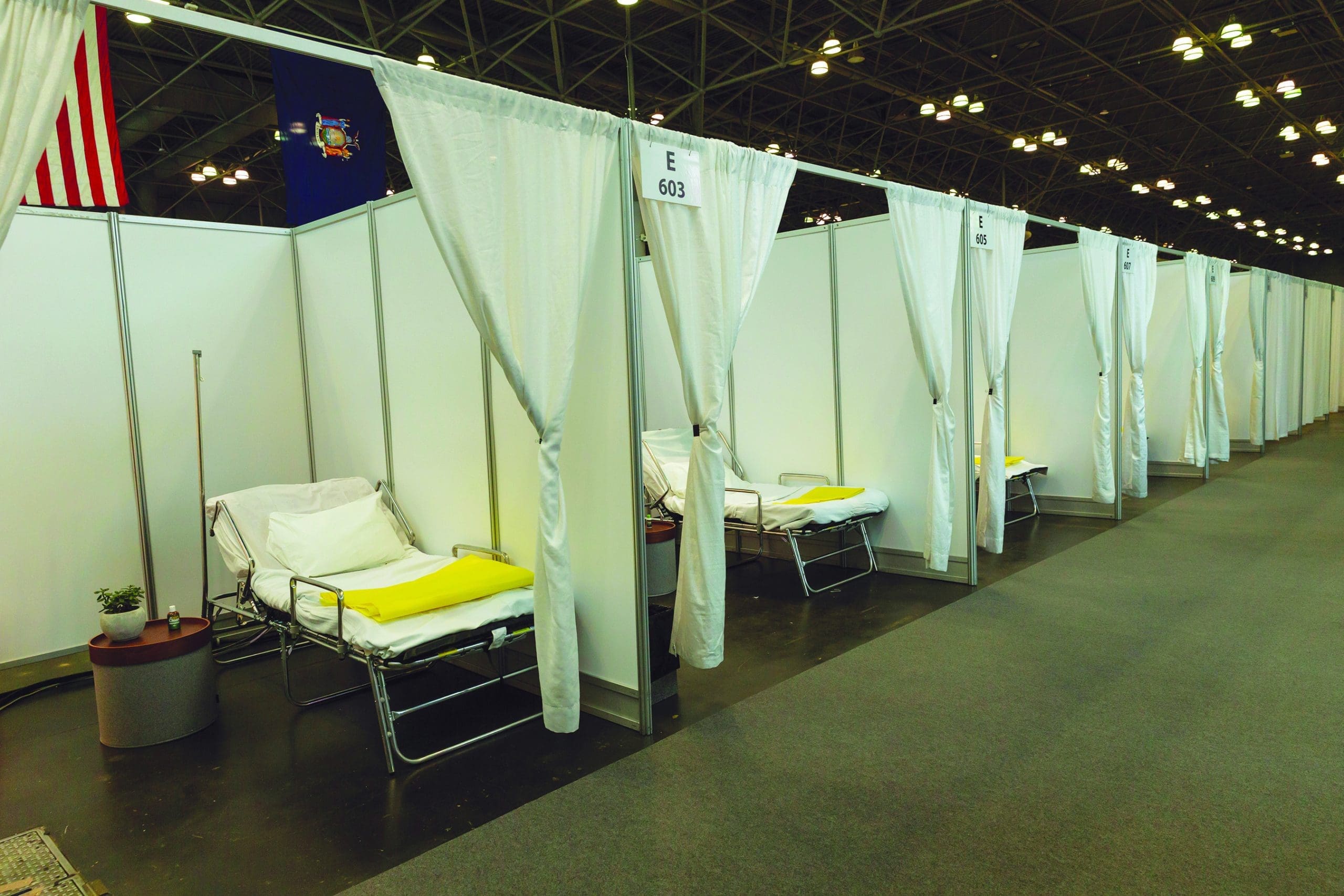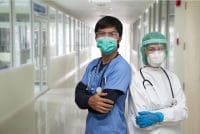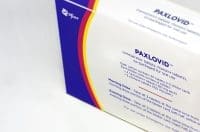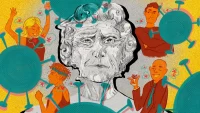Identify challenges and benefits to inform future sites.
- This project sought the perspectives of RNs to understand the challenges, barriers, and benefits of working in COVID-19 alternative care sites (ACSs).
- These recommendations are the first based on direct interviews with RNs working at these sites.
- Project findings can help identify improvements and practical implementations when ACSs are needed in response to future pandemics and disasters.
Increasing hospital capacity offers one solution to addressing the high volume of patients that can occur during a pandemic surge. In response to space constraints at the height of the COVID-19 pandemic, some states established new dedicated facilities and repurposed existing hospitals to support the overflow of patients. Although these alternate care sites (ACSs) helped alleviate bed shortages, mitigate COVID-19 spread, and reduce mortality, they encountered challenges. The existing literature about ACS facilities makes recommendations based on patient observations and prior research rather than direct interviews with healthcare providers in the field. To address this lack of knowledge, a doctorate in nursing student at Duke University implemented a project aimed at understanding RNs’ experiences, with the ultimate goal of using their feedback to inform the creation of future similar work environments.
What we wanted to accomplish
The nursing workforce in pandemic ACSs consisted primarily of agency staff drawn from temporary staffing companies. These nurses hadn’t worked together previously, so we wanted to understand how to develop effective nursing care teams with newly assigned staff. Specifically, we wanted to explore the following three elements related to RNs working in an ACS:
- challenges and barriers
- benefits
- perceptions about effective patient care teams in an ACS environment.
How we did it
We used phenomenological design to understand the lived experiences of the RNs who worked in the ACSs. We prepared interview questions, but the interviewer had the flexibility to ask other clarifying questions to address the project’s aims. We recruited 14 RNs on interim contracts who had worked at four COVID-19 ACS locations in California, Colorado, Missouri, and Maryland. Upon assessment of COVID-19 resurgence risk, state, local, tribal, and territorial governments could create an ACS where healthcare clinicians cared only for acutely ill patients with COVID-19. These nontraditional facilities or closed hospitals were opened, staffed, and equipped as standard functional hospitals to provide medical-surgical and ICU levels of care.
The project leader had recent experience working in a COVID-19 ACS. She emailed a synopsis of the project to her former co-workers and asked them to share it with other healthcare professionals working in ACS facilities. Those interested in participating contacted the project leader to discuss the details and schedule a phone interview.
Inclusion and exclusion criteria
Eligible participants included English-speaking RNs who currently or previously worked at a COVID-19 ACS. We excluded two RNs who withdrew from the project during the interview phase.
Assessment measures
We contacted potential interview subjects to discuss the project and review and obtain informed consent. Next, they participated in a 30- to 60-minute semi-structured phone interview. In the recorded interviews, we asked each participant the same questions in the same order. If a participant had a question about one of the items asked, the interviewer provided clarity. (See What we asked.)
What we asked
Each project participant was asked the same questions in the same order.
Context
1. What is your job title, and how many years have you worked in this title?
2. What is your title at the temporary COVID-19 facility?
3. How long have you worked or did you work in a temporary COVID-19 facility?
4. During what timeframe did you work at an ACS? (How many months and the dates?)
Challenges
5. What challenges and barriers have you experienced working in a temporary COVID-19 facility in the following areas? Please elaborate on each.
- Working with co-workers
- Working with administrators
- Working with patients
- Working with families
- Your family (personally)
- Are there any other challenges or barriers not mentioned that you would like to discuss?
Perceptions
6. What do you consider to be an effective work team in this environment? Please give an example and explain.
7. What are the essential attributes of an effective work team in this environment?
8. What recommendations would you give to another healthcare practitioner attempting to develop an effective work team in a temporary COVID-19 facility?
9. Do you have other recommendations for effectively implementing a temporary COVID-19 facility related to teamwork and getting the facility to work smoothly?
Benefits
10. What are the benefits to care provision in a temporary COVID-19 facility? Please provide an example and elaborate.
Data analysis
To identify themes, three project team members independently listened to, transcribed, and read the interviews. They then met to discuss and agree on the final themes. The data were analyzed using Braun and Clarke’s 6-Phase Thematic Analysis approach, which allows pattern identification via rigorous data familiarization, as well as coding, reviewing, defining, and reporting themes. To ensure and account for accuracy, the team used data analysis software as a supplementary tool to the initial coding process.
Ethical considerations
To protect the privacy of interviewees, we assigned an alphanumeric identifier to interview transcripts. In addition, we saved data from each participant on a password-protected zip drive stored in a locked cabinet.
What nurses told us
The project team designed the context section of the interview tool to help us understand general demographic information about participants. Before and while working at an ACS, most of the participants held the title of staff nurse (RN). The participants’ time working at an ACS ranged from 2 weeks to over 2 years on various shifts. One ACS was projected to remain operational until April 28, 2023.
Participants expressed various reasons for wanting to work at an ACS. Quotes from participants include the following:
- “Well, it was the overwhelming pandemic and the overburden of the healthcare system. So, with my credentials, I jumped in and wanted to help.”
- “I wanted to just work directly with COVID patients. Because at the previous hospital, it was COVID/non-COVID [patients were mixed], and it was a mess. Most of the patients that we were taking care of, the few patients that were non-COVID, they were getting infected.”
- “I wanted to be a part of history.”
The preliminary data analysis identified nine themes, which the team ranked based on the identification of key words and content and the relationships and pattern-matching of the underlying codes. (See Themes identified.)
Themes identified
Based on interviews with 14 nurse participants, the project team identified nine themes.
- Structural/organizational barriers
- Personal challenges
- Co-worker challenges
- Leadership challenges
- Patient and family challenges
- Workload challenges
- Effective teamwork benefits
- Structural/organizational benefits
- Personal benefits
Challenges and barriers
Project participants reported significant structural and organizational barriers related to ACS infrastructure and logistics. The less-than-ideal facilities, lack of support services, and few ACS-specific policies and procedures created substandard work conditions, expansive workloads, and practice variability.
Personal challenges voiced by the participants involved fear of transmitting COVID-19 to their family members, lack of emotional and mental support, and not being home with family. Quotes from participating RNs included the following:
- “The stress, the anxiety, the worry…We constantly worried about getting COVID from the job and taking it to our families.”
- “At the beginning of COVID, stress, PTSD from seeing a lot of death, many people dying so young, many people dying so quick and at higher numbers at the time was very stressful. Like very, I will say, life-changing for me.”
- “Despite what we were doing, people were dying left and right, so that really impacted co-workers emotionally.”
- “A couple of nurses who have been traveling since 2020 say they have PTSD and get major headaches and flashbacks. So, yeah, it is definitely trying.”
Challenges faced by nurses who had never worked together before included a lack of involvement from some co-workers, varying levels of expertise, clashing personalities, and staff turnover. Leadership challenges involved fragmented communication from federal and state governments about implementation and job security, which led to delays in engaging vendors and contractors to convert facilities to ACSs and left employment longevity uncertain.
Nursing staff noted the following:
- “With administrators being in the loop of knowing the initiatives from the State, the regulations, sometimes we are the last to know. Sometimes it is a bit unorganized.”
- “The census ranged from 7 to 103 patients.”
- “… you never know how long this facility will be open or if you’ll have a job.”
- “I would say the communication from management is an issue.
Patient and family challenges experienced by the nurses included lack of patient and family cooperation, distress related to limiting interactions between patients and families, care delivery interruptions caused by ongoing negotiations and visitation restriction explanations to families, and managing scared and angry family members. One RN reported the distress associated with her role of managing patient and family visits: “At least where I worked, I was a gate holder, a key holder… of visitors, and visitors could only come with certain situations if the patient was imminently dying, or the patient was cognitively impaired, and then it was only with special considerations. It was very difficult to have families call me crying and screaming that they wanted to be with their loved ones, and I had to say no. I can honestly say that the worst job I’ve ever had in my life was to have to be that gatekeeper of visitors, and my heart broke for all of these people.”
Nurse participants identified the limited number of human resources, non-nursing staff shortages, and high workload as challenges. They also reported minimal or non-existent ancillary staff (such as housekeeping or case management) and that some care providers avoided direct patient care out of fear of contracting the virus. These situations forced RNs to take on those roles and responsibilities.
Benefits
Some project participants noted supportive and approachable leadership, careful planning, safe infectious disease infrastructure, good communication among departments, and excellent fiscal compensation as benefits to nurses and patients when working in the ACS. Nurses reported more satisfaction when the administration rounded, huddled with the staff daily, and provided flexible schedules. One nurse described the infection control protocols at her ACS: “The facility was set up into zones for infection prevention. Employees had to proceed methodically through the cold (dressing rooms), warm (personal protective equipment [PPE] donning rooms), and hot (patient care areas) zones. PPE was mandatory in warm and hot zones, and employees decontaminated at the end of their shifts.”
At one ACS, RNs received $4,300 for three work shifts and $4,800 for four shifts a week, with no specialty or shift differential. Many participants perceived that patients at COVID-19 ACS facilities had better quality outcomes because of the specialized and innovative care they received, saying such things as: “Patients get better care at an all-COVID hospital,” and “If they had come sooner, it would have been better. We could have saved more lives because of the specialized clinical expertise and virus-focused care provision.”
Perceptions of effective teams
Mutual support, a sense of community, good communication among teams, and relying on each other’s strengths were perceived as effective support strategies. The nurses reported that being flexible, engaged, dedicated, compassionate, and caring and having a professional attitude when dealing with families and patients facilitated the work in the ACS. The all-agency nursing staff perceived the work environment as better than a traditional hospital. One participant said, “I feel like there’s no competition. You don’t usually feel like…anybody is kind of overstepping. Because usually, you go to a hospital, if you’re a traveler, for the most part, the treatment is different. Everybody thinks about how much [money] you’re making just doing the job. As a result, you get very low support. But by doing ACS, it’s different because we are all here as travellers. So, there’s less competition and more support, more teamwork and stuff.” Another participant noted, “Everyone had the same mission, professional treatment was better, and there were fair patient assignments.”
What we learned
As the first report to address the experiences of RNs working in ACS facilities dedicated to caring for patients with COVID-19, this project provides insight into the challenges and barriers of these work environments. It also aids better understanding of the structural and leadership steps that can help create a supportive workplace. (See Project implications.)
Project implications
Results from this project provide insight and recommendations from nurses for future alternate care site (ACS) implementation.
- Provide nurses recruited to work in ACS facilities with realistic expectations.
- Help healthcare leaders understand the importance of personal coping skills to minimize mental health strain.
- Aid the Federal Health Care Resiliency Task Force Alternative Care Site Toolkit (Toolkit) and governments in developing data triggers (such as patient census) for establishing ACS facilities to avoid opening them in regions where they aren’t needed.
- Support modification of the Toolkit to better support ACS implementation.
- Designate regional ACS facilities as crucial for emergency preparedness.
- Recognize the need to retrofit ACS facilities with infection prevention infrastructure (for example, cold, warm, and hot zones).
- Implement quarterly inspections of identified ACS facilities to validate that they meet Centers for Disease Control and Prevention standards for ACS preparedness.
- Structure a nationally identified ACS response team with annual training to facilitate staffing, deployment, and teamwork.
- Establish contractual support services agreements to decrease clinical workloads and stress.
- Create contractual housing agreements or arrangements to decrease stress associated with finding living arrangements while on assignment.
- Develop ACS-specific policies and procedures to support staff performance and practice standardization.
- Establish proactive methods to aid effective communication and decrease staff, patient, and family anxiety.
- Develop communication strategies for notifying regional hospitals and emergency medical services of the availability of an ACS to support hospital overflow of patients with COVID-19.
- Identify research from diverse healthcare professionals’ perspectives to detect remaining challenges.
- Determine research needed on the quality outcomes of COVID-19 ACS facilities compared with traditional hospitals.
- Identify research needed on travel nurse experiences and perceptions in traditional hospitals to improve work conditions.
- Provide future ACS leadership with information to help improve site implementation.
- Share information with traditional healthcare facilities to heighten disaster preparedness efforts.
- Help leadership groups, such as the American Hospital Association and American Organization for Nurse Leadership, develop public policy and health advocacy efforts.
Interpretation
This project identified some of the barriers, challenges, and benefits experienced by RNs working in ACS facilities. The organizational structure served as both a benefit and a challenge. This dichotomy highlights the intricacies of healthcare systems, primarily when operating in highly complex and unpredictable environments.
In addition to barriers and challenges, nurses described benefits. They listed a clear organizational structure or careful planning, supportive and approachable leadership, good communication among teams and departments, and effective teamwork with mutual support as positive facilitators. Understanding all these factors will help those tasked with developing ACSs recognize barriers and plan proactively for their resolution. In addition, understanding the challenges and benefits will help recruit nurses by providing them with a full understanding of what to expect during their time at the ACS.
Limitations
The data from 14 nurses working in four ACS facilities in four states limits generalizability to other ACS facilities. However, the strength of this project is found in the depth of information explored rather than the number of participants. This single project addressing the experiences of RNs working in ACS facilities dedicated to treating and caring for COVID-19 patients can’t stand alone; additional studies are needed.
Structural support, approachable leadership
Nurses working in COVID-19 ACS facilities encounter challenges and barriers that can result in mental health and emotional implications. Clear organizational structure, supportive and approachable leadership, and effective teamwork creates a sense of community and a positive ACS work environment. This project’s findings can help state, local, tribal, and territorial entities and healthcare leaders implement the necessary organizational structure and resources to support healthcare professionals working under stressful conditions.
Irma Arnese Stern is a national interim nurse leader, strategist, and consultant. Marion Broome is a professor of nursing at Duke University in Durham, North Carolina. Barbara Turner is a professor of nursing at Duke University. Mary Ann Fuchs is executive advisor to the CEO at Duke University Health System.
American Nurse Journal. 2023; 18(6). Doi: 10.51256/ANJ062318
References
Ardebili ME, Naserbakht M, Bernstein C, Alazmani-Noodeh F, Hakimi H, Ranjbar H. Healthcare provider’s experience of working during the COVID-19 pandemic: A qualitative study. Am J Infect Control. 2021;49(5):547-54. doi:10.1016%2Fj.ajic.2020.10.001 10.1016/j.ajic.2020.10.001
Begun JW, Jiang HJ. Health care management during COVID-19: Insights from complexity science. NEJM Catalyst. 2020. catalyst.nejm.org/doi/pdf/10.1056/CAT.20.0541
Braun V, Clarke V. Using thematic analysis in psychology. Qual Res J Psychol. 2006;3(2):77-101. doi:10.1191/1478088706qp063oa
Chen S, Zhang Z, Yang J, et al. Fangcang shelter hospitals: A novel concept for responding to public health emergencies. Lancet. 2020;395(10232):1305-14. doi:10.1016/S0140-6736(20)30744-3
Federal Healthcare Resilience Task Force. Federal Healthcare Resilience Task Force Alternate Care Site Toolkit. U.S. Department of Health and Services. 2020. files.asprtracie.hhs.gov/documents/acs-toolkit-ed1-20200330-1022.pdf
Figueroa CA, Harrison R, Chauhan A, Meyer L. Priorities and challenges for health leadership and workforce management globally: A rapid review. BMC Health Serv Res. 2019; 19(239). doi:10.1186/s12913-019-4080-7
Hick JL, Barbera JA, Kelen GD. Refining surge capacity: Conventional, contingency, and crisis capacity. Disaster Med Public Health Prep. 2009;3(S1):S59-67. doi: 10.1097/DMP.0b013e31819f1ae2
Kearns RD. Managing a medical surge. In: Kluger Y, Coccolini F, Catena F, Ansaloni L (eds). WSES Handbook of Mass Casualties Incidents Management. Philadelphia, PA: Springer; 2019.
McCabe R, Schmit N, Christen P, et al. Adapting hospital capacity to meet changing demands during the COVID-19 pandemic. BMC Med. 2020;18(1):329. doi:10.1186/s12916-020-01781-w
Ong ACW, Wee CLP, Lee WL, Goh LG, Lim GH. Experience from a multi-disciplinary team against COVID-19: A healthcare perspective. Int J Environ Res Public Health. 2021;18(4):1678. doi:10.3390/ijerph18041678
U.S. Department of Health and Human Services. Hospital experiences responding to the COVID-19 pandemic: Results of a national pulse survey March 23-27, 2020. oig.hhs.gov/oei/reports/oei-06-20-00300.pdf
Yin RK. Case Study Research Design and Methods. 5th ed. Thousand Oaks, CA: SAGE Publications; 2013.
Key words: COVID-19 alternative care sites, emergency preparedness, nurse perception


















